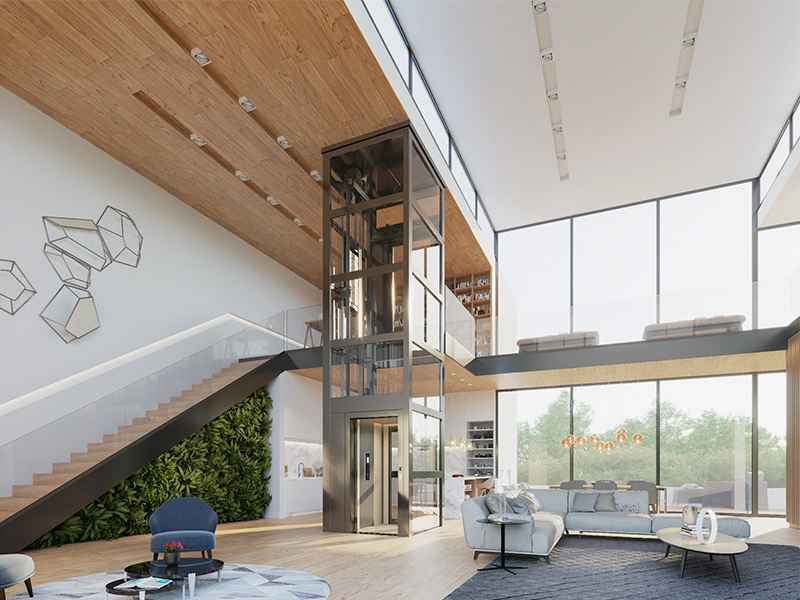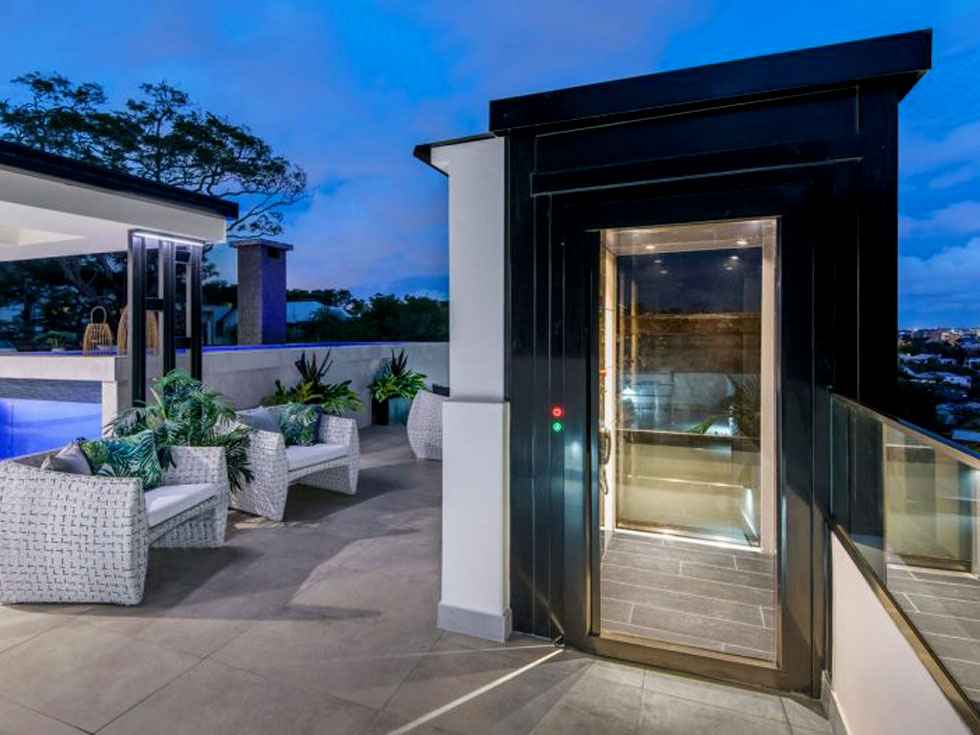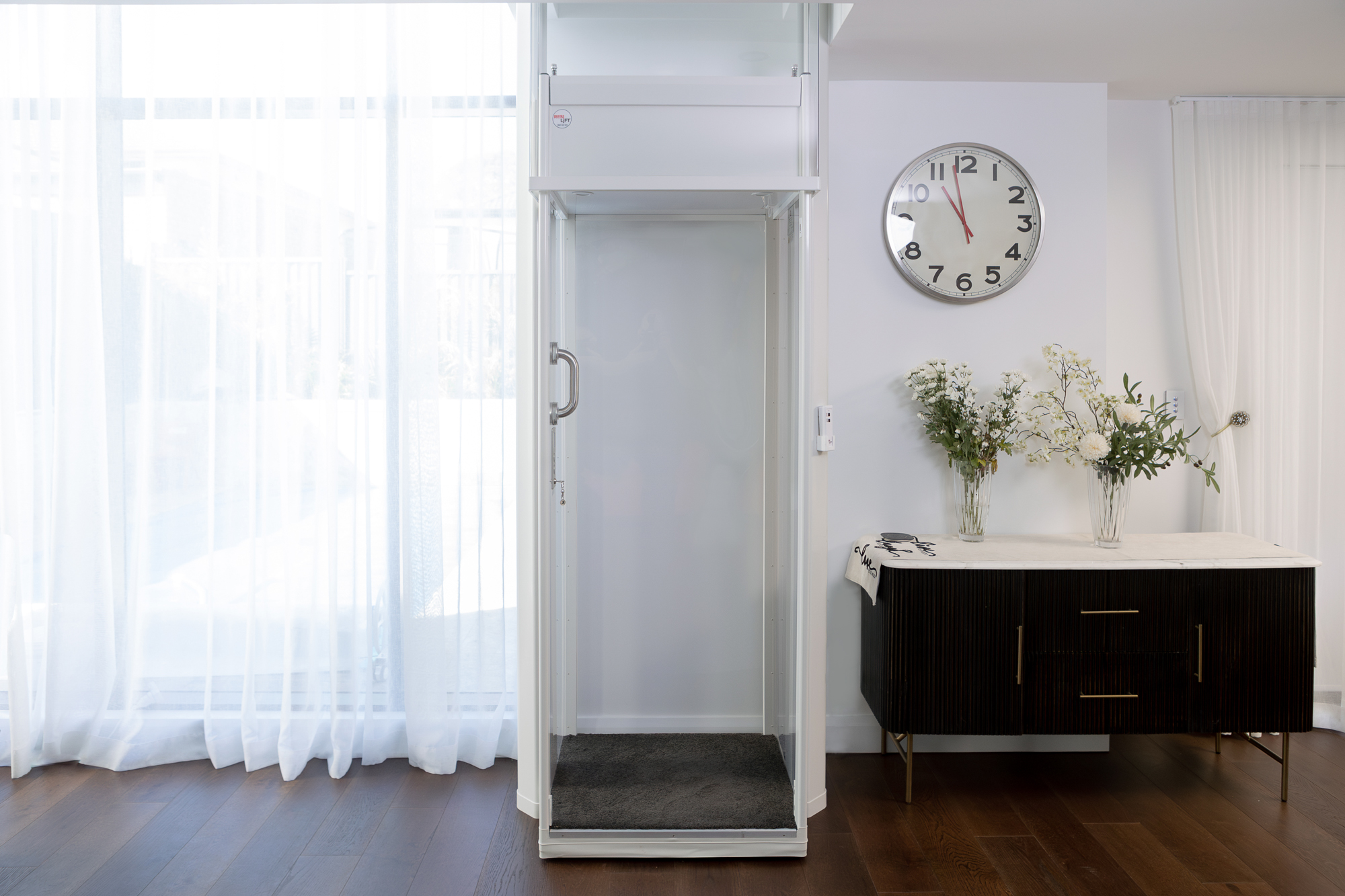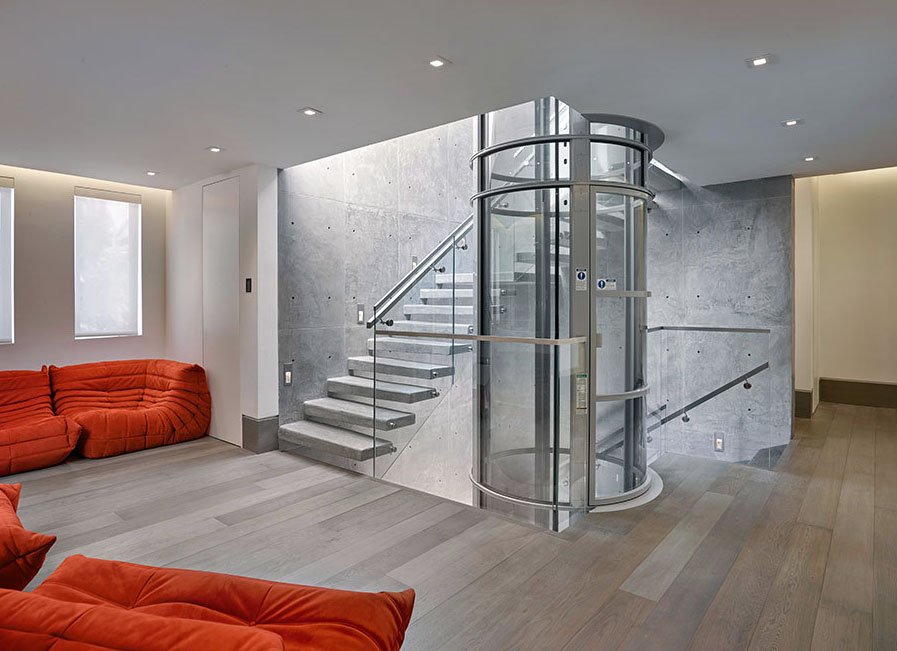Home Lift Products
Electric (Traction) Lifts

Overview:
Traction lifts are arguably the most common type of home lift. Also known as electronic elevators, these lifts are operated by way of rolling steel ropes that are laid over grooved pulleys.
The weight of the elevator car is balanced by a counterweight on the other side, although there are times when two elevators are built so that their cars move synchronously. However, for the purpose of residential use, the point is to get a strong counterweight that can help carry the lift’s load.
Price*: Between $55,000 - $85,000
Offered by: Infinity Lifts, Direct Lifts, PR King and more...
Hydraulic Elevators

Overview:
Hydraulic home lifts are another notable lift type. Unlike traction lifts, they don’t use any overhead hoisting machinery. Instead, they use fluid-driven pistons mounted inside cylinders to carry the cab. The fluids are usually oil-based, meaning that they would need to be replaced often to ensure operational efficiency.
Price*: Between $50,000 - $80,000
Offered by: Direct Lifts, Aussie Lifts, Elite Elevators and more...
Through-Floor/Shaftless Home Lifts

Overview:
Through-Floor Lifts are one of the most cost-effective and easiest to install lift models available on the market. Purpose built for two storey homes, Shaftless lifts allow you to install a lift that covers two stops in only a few days for potentially $10,000 - $15,000 cheaper than a traditional electric or hydraulic lift in the same setting.
Through-Floor Lifts are also perfect for retrofitting into an existing home, as there being no need for a shaft and a pit being optional, they take up very little space and do not require major modifications to be made to install.
Price*: Between $35,000 - $48,000
Offered by: RESiLIFT, Savaria, Pollock Home Lifts and more...
Enclosed Platform Lifts (EPL)

Overview:
Enclosed Platform Lifts are also another style seriously worth considering, especially if you are retrofitting a lift into an existing 2-storey home.
Enclosed Platform Lifts provide a more traditional lift experience without the need to build a dedicated lift shaft and pit. This is great as like a shaftless home lift, you save $10,000 - $15,000 by not needing to build a shaft.
EPL’s are typically powered by an electric screw and nut drive system, raising the platform as you stand on it within the enclosed shaft.
Price*: Between $45,000 - $60,000
Offered by: Lifts For Life, Shotton Lifts, Direct Lifts and more...
Machine-Room-Less (MRL) Lifts

Overview:
Machine-room-less lifts are an interesting innovation in the lift space. These lifts are popular primarily because they don’t need any additional rooms to operate. Also known as MRLs, these lifts work by placing their drives and controllers in the hoistway - meaning that they don’t need a machine room, which is generally kept in a separate room or under the lift, to store those components.
For homes with space limitations, MRLs are a very solid option.
Price*: Between $50,000 - $65,000
Offered by: Austand Elevator, Savaria, Delta Elevators and more...
Vacuum Lifts

Overview:
Vacuum lifts are another interesting innovation in the industry. With extensive applications for residential areas, these lifts have also changed the way that people move from one level to the other in their homes.
With multiple models and even wheelchair-accessible options, vacuum lifts are an ideal fit for just about any home or application. They offer a minimal energy footprint, quick installation, and an innovative design that makes them a truly versatile option.
Price*: Between $35,000 - $55,000
Offered by: Nibav Home Lifts, Direct Lifts, Vacuum Elevators and more...
What Is A Home Lift?
A home lift is a powered device that is built to raise an occupant. These lifts help you to easily get from one floor to the other in your home, eliminating the need for stairs.
While they used to be seen as luxuries, home lifts have actually become necessary for some people. Those with mobility issues or injuries could have lifts installed in their homes, ensuring that they can easily move from floor to floor without stress or having to get out of their wheelchair.
In the home, a home lift setting consists usually of the lift car, a shaft, and the controls needed to operate the entire system.
How do Home Lifts Work?
Primarily, the operation method for home lifts varies depending on the type of lift. However, there are some common features that all lift types share. For one, home lifts in Australia will need to be built in accordance with the country’s standards to ensure that they are safe to use.
More specifically, lifts need to be built following AS1735.18- Passenger lift for private residence. This is a code that ensures that your lift is built to meet the minimum safety standards.
To set up a home lift, you will need to have the following:
- Enough space for the lift and its shaft
- A permanent source of power supply - and, in some cases, a backup power source for when the main source has a problem
- A phone line with an active SIM card for emergencies.
When working home lifts, the first step is usually to build an elevator shaft to house the lift. Of course, you could also purchase a ready-made shaft to house it. Note that lifts can also be customised to fit the available space in your house.
Types Of Lifts
Home lifts come in different forms. The most popular, however, include the following:
Traction Home Lifts
How Do Traction Home Lifts Work?
A traction lift usually consists of the following components:
- A pulley (also known as a sheave)
- A motor
- A counterweight
- Cables (or ropes, if you will)
Some traction lifts also come with gears that are housed between the pulley and the motor, while others will connect the motor directly to the pulley. Cables are usually made of multi-strand steel for optimal security.
All in all, a traction lift works with a relatively simple system. The motor is attached to the pulley, with the cable looped over it. One end of the cable is attached to one end of the lift car, while the other end is attached to the counterweight.
When the lift is ready to rise, the motor turns the pulley. As the lift car rises, the counterweight is lowered - and vice versa. Thanks to the counterweight, there is less strain on the entire system. So, less power is required to propel the lift car in either direction.
Most traction lift models also come with Overspeed Governors, which monitor their speed.
Traction Home Lifts Pros & Cons
Pros
Less Space
By design, traction lifts require much less space than most other home lift types. For one, hydraulic lifts need a lot of oil stored in a reserve, while traction lifts don’t.
Greater Speed
Traction lifts are arguably the fastest option available. So, if speed is a requirement for you in a home lift, then a traction lift is perhaps the right option for you. This, combined with the space requirement, makes the lifts a good choice for homes.
Lower Maintenance
Traction lifts also come with no fluid systems and fewer mechanical operations. This means that they don’t have as many maintenance requirements as other lift types. In terms of maintenance costs, these lifts are ideal as well.
Cons
Not Ideal for Every Home
While traction lifts require comparatively less space than most other lift types, you still need ample space to install them in your home.
Higher Cost
Manufacturers know that traction lifts are more energy-efficient and faster than most other lift types. So, the lifts unsurprisingly cost more as well.
Hydraulic Home Lifts
How Do Hydraulic Home Lifts Work?
Hydraulic lifts work with pistons and pumps. Ideally, the pistons are connected to the elevator, while the pumping unit is kept in a separate room.
Generally, a hydraulic lift’s piston is connected to it within a hoistway - while the pumping unit is kept in a different room. Once the lift is activated, the hydraulic system moves pressurized liquid into a cylinder, from which the liquid moves to the piston and causes the lift to go up.
The reverse happens when the lift is moving down - the fluid is moved from the hydraulic system to its reservoir, making it easy for the lift to move downwards.
Hydraulic Home Lifts Pros & Cons
Pros
Higher Weight Capacity
Hydraulic lift systems hold a significantly higher level of weight. Even better, they can handle custom-made cabs, so your needs can be better accommodated.
Less Noise When Operating
Thanks to its hydraulic system, hydraulic lifts move more smoothly and quietly. For households where a relaxed ambiance is required, hydraulic lifts are for you.
Minimal Headroom Required
Since hydraulic lifts store their equipment in separate rooms, the cabs themselves take up little space. They don’t need ample headroom as well, so they work for homes with low-hanging ceilings.
Cons
Higher Power Requirements
Hydraulic lifts primarily come with more power requirements - especially since they can hold more weight.
Much Slower
The hydraulic system works with fluid controls, meaning that these lifts are usually much slower than traction lifts.
Machine Room Required
For homes with minimal space, hydraulic lifts might not be the best since they require additional rooms to store their pumping units.
Machine-Room-Less Home Lifts
How Do Machine-Room-Less Home Lifts Work?
MRLs can either be traction or hydraulic.
For the traction variants, the MRLs install the traction machines on either the hoistway's top side wall or the bottom side of the lift shaft. The motor is installed with the use of a permanent magnet, which sticks the motor permanently and works with a Variable Voltage Variable Frequency (VVVF) drive. This design entirely eliminates the need for a fixed machine room, saving a great deal of space.
As for the hydraulic variants, a similar design is used. There is no need for a fixed room to house the pumping unit since it is installed in the elevator pit. The controller is also placed on a wall close to the lift- usually on the bottom floor.
Machine-Room-Less Home Lifts Pros & Cons
Pros
Space Saving
As expected, the primary benefit of an MRL is the fact that it saves you a great deal of space since you don’t need to get a separate room to house any of the equipment.
Affordable
Thanks to the use of the Variable Voltage Variable Frequency (VVVF) drive, MRLs could cost less than other lift types in terms of installation.
Lower Energy Requirement
MRLs save an estimated 70-80% of energy compared to traditional hydraulic lifts thanks to their more efficient design.
Cons
No Installation Standards Yet
For now, there is no code or approved standard that governs the installation of MRLs in residential homes. However, this is expected to change soon.
Relatively Loud
Due to the presence of the VVVF drive, MRLs usually operate with loud, high-frequency sounds when they run.
Limitations
In most cases, MRLs are also limited when it comes to several major factors - including speed, weight capacity, and cab interior holding ability.
Vacuum Lift
How Do Vacuum Home Lifts Work?
Vacuum lifts are powered by air. In a normal system, air is pulled using turbines placed at the top of the shaft, and the air creates a vacuum that pulls the lift car up. Air pressure is slowly released through a pumped valve, causing the lift car to go up or down and creating a frictionless movement.
As the lift car goes up, steel brakes immediately get engaged to secure it at its landing spot and when the car goes down, the turbines briefly turn on and the lift turns its brakes off. Then, the brakes get re-engaged as the car reaches the desired level.
Vacuum Home Lifts Pros & Cons
Pros
Quick Installation
Thanks to their mode of operation, vacuum lifts are actually installed much quicker. The lifts are also known for being ready to use in much shorter times than most traditional elevator types.
Space Saving
Another significant benefit of vacuum lifts is that they don’t require additional room to place any complex operating components.
Less Energy Consumption
Vacuum lifts use the force of gravity to move up and down, and since there aren’t any complex hydraulic systems powering them, their energy consumption is comparatively lower.
Cons
Limited Privacy
Vacuum lifts are installed in plain sight. So, if you need privacy in your home as you move from one floor to the other, they might not be the best bet.
Lower Capacity
Vacuum lifts are usually much smaller than traditional lift options. While they occupy less space, it also means that they can’t carry as much load.
Home & Residential Lift Prices Australia
Usually, the total cost of getting a home lift in Australia ranges between $25,000 and $100,000. The exact price you pay will vary based on several factors, which we will examine later. You can learn more about home lift prices in Australia with our in-depth guide.
What To Consider Before Purchasing A Home Lift
Deciding if a home lift is the ideal mobility option for you will depend on several factors, including the following:
Position Of The Lift
One of the first things you need to consider will be the position of the lift. You need to consider how far you need the lift to travel, as well as whether you have enough room on every floor for the shaft and a landing area.
Your Personal Needs
It’s also important to consider your actual needs. Do you want to transport people, things, or a combination of both? How many people will need to use it? Would you need to fit a wheelchair in the lift?
Things like these need to be considered before you choose an option.
Safety Features
As always, remember to consider the lift’s safety features. The lift needs to be constructed to prevent accidents, and you also need to ensure that it is installed in accordance with relevant codes and standards.
From brakes to automatic doors and walls surrounding the lifts, all of these safety features need to be considered.
Servicing Requirements
No machine works perfectly forever. Eventually, you will need to maintain the lift to keep it in top shape. And some lifts have strict maintenance and servicing requirements that you need to adhere to.
Just as well, you might want to consider the maintenance costs when choosing the type of lift you’d like.
Type Of Drive Systems
Would you prefer a traction lift or a hydraulic lift? Or would you prefer a newer option like the vacuum or MRL? Select the right drive system based on your requirements, and you have another huge advantage.
Choosing The Right Dealer
Who you buy a lift from is just as important as the type of lift you buy. It’s important for you to look around until you find a dealer whose terms are perfect for you.
With the right dealer, issues like maintenance, installation, and warranties will quickly be taken care of.
Lift Installation
Generally, the process of installing a home lift can be broken down into the following sections:
Lift Selection
Before choosing a lift, consider the many options available to you. This way, you know what you’re getting and how it will make your life easier. Remember to consider the factors listed above before choosing a lift.
Contract Preparation & Signing
The next step is to order your residential lift. Before you sign an order contract, be sure to read its terms and understand what the manufacturer is offering.
Examine terms such as lift specifications, lift finishes, payment and program schedules, and much more. If the need arises, don’t be afraid to ask questions.
Lift Drawing Preparations
Once the contract is signed and you’ve paid the deposit amount, the manufacturer will offer engineered lift drawings. These drawings will contain all important metrics and measurements for your lift for reference purposes.
On-Site Liaison
Lift installation companies will also assist in the on-site shaft construction. They can make last-minute changes before going ahead with approvals for the lift installation.
Here, important issues to be discussed include safety features, electrical requirements, landing areas, control cabinet locations, and more.
Finishing Touches
A final return to the showroom will be required to finalise the lift finish selections. Be sure not to rush this process - take samples and go through every detail one last time, so you know everything’s right.
Delivery & Installation
The lift company eventually notifies you when it is ready to be delivered. A final site inspection is conducted by the project manager, then the lift is installed.
Usually, it takes between 2 to 4 weeks for the installation to be ready.
Comprehensive Testing
Following the installation, several tests will be conducted to ensure that the lift truly works and operates up to code.
Home Lift Benefits
Why should you install a home lift? Perhaps these benefits will convince you:
Increase In Property Value
If you’re looking to sell your home in the future, having a home lit undoubtedly helps you to fetch a higher price for it. Some homeowners see lifts as a necessity, and they will be more than happy to pay for them.
Better Accessibility Throughout Your Home
If you live in a building with more than one floor, a home lift definitely improves accessibility. You can easily move from one floor to the other without having to deal with stairs.
Improved Safety
For people with limited mobility, stairs can be difficult to maneuver and dangerous to use. Lifts eliminate this risk, allowing you to move around more safely.
Age In Place
If you’ve finally gotten your dream home and would like to stay there forever, there’s no reason why you shouldn’t make it as comfortable as possible now, so it caters to you when you’re old.
For this reason, home lifts are a great investment for the future.
Home Lift Disadvantages
That said, there are also some demerits that might discourage you from getting a home lift depending on your needs. These include:
Cost Considerations
While the cost of installing home lifts isn't quite as high as it used to be, these lifts are still quite costly. You would want to consider your financial capability before going ahead.
Space Requirements
Even the most compact of lifts still takes up some considerable space and if your home doesn’t have ample space, then it may be difficult to efficiently install and operate a lift.
Maintenance
Like all machines, lifts need to be properly maintained to optimize utility. So, you need to adhere to a strict maintenance schedule and pay for it as well.
FAQ
How Much Does A Lift Installation Cost?
Generally, lift installation costs vary based on several factors - including the type of lift, additional safety features, aesthetic components, and even the manufacturers themselves.
Your installation cost will usually be added as part of your final price quote, so be sure to look out for it.
How Long Does Lift Installation Take?
Home lift installations usually take between 2 to 4 weeks from the date of installation commencement. However, the amount of time taken will also depend on several factors - such as safety features, the type of elevator drive, and whether you’re installing your lift in a new or existing home.
You should also keep in mind that there will be additional tests to be carried out post-installation.
Can I customise my lift?
Most lift options and manufacturers allow you to enjoy a certain level of customisation. We recommend asking for different customisation options as part of the consultation phase.
What standards do lifts have to meet?
For Australian users, home lifts will need to meet AS 1735. The standards clearly dictate requirements for lifts with respect to operation, safety, and more.
How long does it take to install a lift?
Lift installation timelines will depend on the project’s specifics. So, be sure to explain what you would like in detail to the manufacturer, so they can provide proper disclosure of the installation timeline.
Your Home Lift, Your Choice: Get & Compare Up To 3 Quotes From Professional Lift Installers To Save Time & Money. It’s Free!

